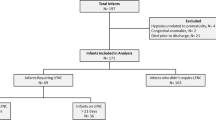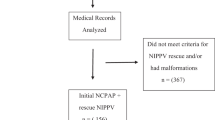Abstract
Objective:
Although interest in nasal continuous positive airway pressure (nCPAP) to avoid intubation is increasing, there is limited data regarding patient selection and outcome. We sought to determine the baseline parameters associated with failure.
Study Design:
In all, 938 cases of elective nCPAP use were extracted from our registry. Two primary end points, Treatment Failure (need for intubation) and Bad Outcome (death, need for respiratory support at 40 weeks post conceptual age, grade 4 intraventricular hemorrhage or periventricular leucomalacia), and 12 potentially predictive baseline parameters were prospectively defined and evaluated using logistic regression.
Result:
Intubation occurred in 31%, and Bad Outcome occurred in 11%. Besides estimated gestational age (EGA), only a few variables were significant predictors in the multivariate models: Intubation (PaO2/FiO2<150 or pH< 7.25) and Bad Outcome (FiO2, low weight for EGA). The relative risk doubled between infants of 34 and 26 weeks EGA and increased by about 50% for those meeting the other criteria.
Conclusion:
We hope these findings will help those using elective nCPAP to refine their practice and those considering its use in establishing reasonable guidelines, as well as be useful for designing clinical research.
This is a preview of subscription content, access via your institution
Access options
Subscribe to this journal
Receive 12 print issues and online access
$259.00 per year
only $21.58 per issue
Buy this article
- Purchase on Springer Link
- Instant access to full article PDF
Prices may be subject to local taxes which are calculated during checkout



Similar content being viewed by others
References
Gregory GA, Kitterman JA, Phibbs RH, Tooley WH, Hamilton WK . Treatment of the idiopathic respiratory distress syndrome with continuous positive airway pressure. N Engl J Med 1971; 284: 1333–1340.
Horbar JD, Badger GJ, Carpenter JH, Fanaroff AA, Kilpatrick S, LaCorte M, et al., Members of the Vermont Oxford Network. Trends in mortality and morbidity for very low birth weight infants, 1991–1999. Pediatrics 2002; 110: 143–151.
Davis PG, Henderson-Smart DJ . Nasal continuous positive airways pressure immediately after extubation for preventing morbidity in preterm infants. Cochrane Database Syst Rev 2003; (2) Art. no.: CD000143.
Bachman TE, Marks NE, Rimensberger PC . Factors effecting adoption of new neonatal and pediatric respiratory technologies. Intensive Care Med 2008; 34 (1): 174–178.
Van Marter LJ, Allred EN, Pagano M, Sanocka U, Parad R, Moore M et al. Do clinical markers of barotrauma and oxygen toxicity explain interhospital variation in rates of chronic lung disease? Pediatrics 2000; 105: 1194–1201.
Kirchner L, Weninger M, Unterasinger L, Birnbacher R, Hayde M, Krepler R et al. Is the use of early nasal CPAP associated with lower rates of chronic lung disease and retinopathy of prematurity? Nine years of experience with the Vermont Oxford Neonatal Network. J Perinat Med 2005; 33 (1): 60–66.
Jonsson B, Katz-Salamon M, Faxelius G, Broberger U, Lagercrantz H . Neonatal care of very low birth weight infants in special-care units and neonatal intensive care units in Stockholm: early nasal continuous positive airway pressure verses ventilation: gains and losses. Acta Pediatr Suppl 1997; 419: 4–10.
Swietlinski J, Bober K, Gajewska E, Helwich E, Lauterbach R, Manowska M et al. Introduction of Infant Flow nasal continuous airway pressure as a standard of practice in Poland: the initial 2-year experience. Pediatr Crit Care Med 2007; 8: 109–114.
Subramaniam P, Henderson-Smart DJ, Davis PG . Prophylactic nasal continuous positive airways pressure for preventing morbidity and mortality in very preterm infants. Cochrane Database Syst Rev 2005; (3) Art. no.: CD001243.
Morely CJ, Davis PG, Doyle LW, Brion LP, Hascoet JM, Carlin JB, for COIN Trial Investigators. Nasal CPAP or intubation at birth for very premature infants. N Engl J Med 2008; 358: 700:8.
Sandri F, Ancora G, Lanzoni A, Tagliabue P, Colnaghi M, Ventura M.L, on behalf of the Pneumonology Study Group of the Italian Society of Neonatology. Prophylactic nasal continuous positive airways pressure in newborns of 28–31 weeks gestation multicentre randomized controlled clinical trial. Arch Dis in Child Fetal and Neonatal Ed 2004; 89: F394–F398.
Jegatheesan P, Keller RL, Hawgood S . Early variable-flow nasal continuous positive airway pressure in infants ⩽1000 g at birth. J Perinatol 2006; 26: 189–196.
deKlerk AM, deKlerk RK . Nasal continuous positive airway pressure and outcomes of preterm infants. J Paediatr Child Health 2001; 37: 161–167.
Ammari A, Suri M, Milisavljevic V, Sahni R, Bateman D, Sanocka U . Variables associated with the early failure of nasal CPAP in very low birth weight infants. J Pediatr 2005; 147 (3): 341–347.
Lim NL, Zulfiqar MA . Predictors of failure of nasal continuous positive airway pressure in treatment of preterm infants with respiratory distress syndrome. J Trop Pediatr 2000; 46 (Suppl 3): 172–175.
Ho JJ, Subramaniam P, Henderson-Smart DJ, Davis PG . Continuous distending pressure for respiratory disrtress syndrome in preterm infants. Cochrane Database Syst Rev 2002; (2) Art. no. CD002271.
De Paoli AG, Davis PG, Faber B, Morley CJ . Devices and pressure sources for administration of nasal continuous positive airway pressure (NCPAP) in preterm neonates. Cochrane Database Syst Rev 2008; (Suppl 1): CD002977.
Acknowledgements
We wish to recognize Professor Elsbieta Gajewska without whose vision and leadership the Neonatal Noninvasive Respiratory Study Group would not have been possible. We are also extremely grateful to Mr Jerzy Owsiak of The Great Orchestra of Christmas Foundation for generous support both to our research and to the 600 pediatric units in Poland.
Author information
Authors and Affiliations
Consortia
Corresponding author
Rights and permissions
About this article
Cite this article
Swietlinski, J., Bachman, T., Gajewska, E. et al. Factors affecting outcomes in very low birth weight infants treated electively with nasal continuous positive airway pressure. J Perinatol 30, 112–117 (2010). https://doi.org/10.1038/jp.2009.135
Received:
Revised:
Accepted:
Published:
Issue Date:
DOI: https://doi.org/10.1038/jp.2009.135



